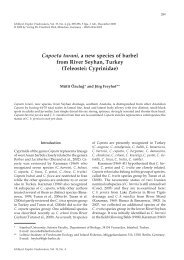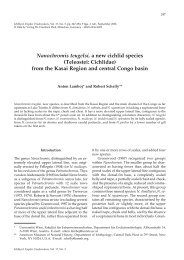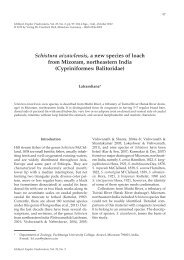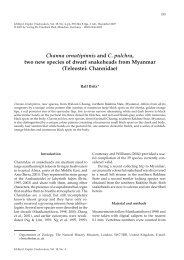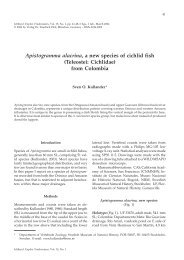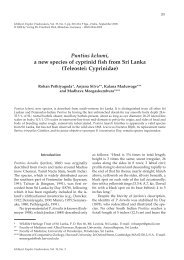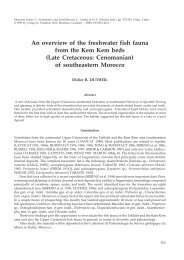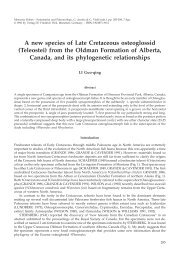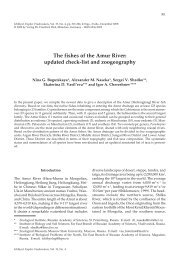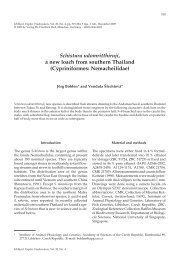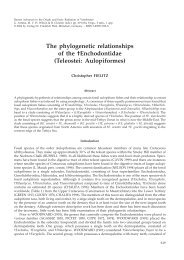A synopsis of the South Asian fishes referred to Puntius - Verlag Dr ...
A synopsis of the South Asian fishes referred to Puntius - Verlag Dr ...
A synopsis of the South Asian fishes referred to Puntius - Verlag Dr ...
You also want an ePaper? Increase the reach of your titles
YUMPU automatically turns print PDFs into web optimized ePapers that Google loves.
86<br />
a<br />
b<br />
Fig. 10. Barbus bovanicus, AMS B.7829, lec<strong>to</strong>type, 95.1 mm SL; India: Bhavani River, Tamil Nadu; a, pho<strong>to</strong>graph;<br />
b, radiograph.<br />
<strong>the</strong>ir ‘pentazona group’ (‘S.’ everetti, ‘S.’ lateristriga,<br />
‘S.’ pentazona and ‘S.’ rhomboocellatus) possesses<br />
<strong>the</strong>m; Taki et al. (1978) also distinguished <strong>the</strong> two<br />
groups by <strong>the</strong>ir colour patterns.<br />
<strong>Dr</strong>avidia. Menon (1999) chose <strong>the</strong> junior name<br />
Labeo melanampyx Day, 1865 over its senior subjective<br />
synonym, Cirrhinus fasciatus Jerdon, 1849 (<strong>the</strong><br />
type species <strong>of</strong> <strong>Dr</strong>avidia) citing Art. 23(b) <strong>of</strong> ICZN<br />
(1985), on <strong>the</strong> grounds that <strong>the</strong> former was “a<br />
favourite aquarium fish and several aquarium<br />
journals mention this species as <strong>Puntius</strong> melanampyx.<br />
A change is not considered desirable.”<br />
However, Art. 23(b) <strong>of</strong> ICZN (1985) requires that<br />
such a case is <strong>to</strong> be <strong>referred</strong> <strong>to</strong> <strong>the</strong> Commission<br />
for a ruling, which has not been done in <strong>the</strong> 13<br />
years following Menon (1999). As such, we follow<br />
Arts. 23.1 and 22.9.3 <strong>of</strong> ICZN (1999) and use <strong>the</strong><br />
senior synonym C. fasciatus, which anyway is also<br />
<strong>the</strong> name in prevailing usage (e. g., Silas, 1956;<br />
Jayaram, 1991; Talwar & Jhingran, 1991; Arunachalam,<br />
2000; Bhat, 2005).<br />
Three additional <strong>South</strong> <strong>Asian</strong> species included<br />
in <strong>Puntius</strong> by previous authors (e. g.,<br />
Jayaram, 1991; Talwar & Jhingran, 1991) bear two<br />
pairs <strong>of</strong> barbels and a smooth last unbranched<br />
dorsal-fin ray: ‘P.’ bovanicus, ‘P.’ carnaticus and<br />
‘P.’ jerdoni. Barbus bovanicus (AMS B.7829, syntype,<br />
95.1 mm SL, here designated lec<strong>to</strong>type; Fig. 10)<br />
has 9 branched dorsal-fin rays, 23 lateral-line<br />
scales on body, eye in upper half <strong>of</strong> head, thick,<br />
fleshy lips, and <strong>the</strong> lower lip present medially: it<br />
is apparently a Neolissochilus. It fur<strong>the</strong>r differs<br />
from all species <strong>of</strong> <strong>Puntius</strong>, Sys<strong>to</strong>mus, Dawkinsia,<br />
Pethia and <strong>Dr</strong>avidia in possessing 22 (vs. 13-19)<br />
caudal vertebrae and 6 (vs. 3-5) supraneurals. We<br />
note in passing that <strong>the</strong> spellings bovanicus and<br />
bovianicus were published simultaneously, in plate<br />
138 fig. 1, and on page 566, <strong>of</strong> Day (1878), both <strong>of</strong><br />
which were released on 1 December 1878 (see<br />
Whitehead & Talwar, 1976: 54 and references<br />
<strong>the</strong>rein). In keeping with subsequent usage, as<br />
first reviser we give B. bovanicus precedence over<br />
B. bovianicus.<br />
Pethiyagoda et al.: Synopsis <strong>of</strong> <strong>South</strong> <strong>Asian</strong> <strong>Puntius</strong>




